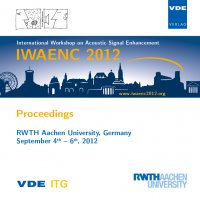Underdetermined Source Detection and Separation Using a Normalized Multichannel Spatial Dictionary
Konferenz: IWAENC 2012 - International Workshop on Acoustic Signal Enhancement
04.09.2012-06.09.2012 in Aachen, Germany
Tagungsband: IWAENC 2012
Seiten: 4Sprache: EnglischTyp: PDF
Persönliche VDE-Mitglieder erhalten auf diesen Artikel 10% Rabatt
Autoren:
Fakhry, Mahmoud; Nesta, Francesco (Center of Information Technology, Fondazione Bruno Kessler - Irst, via Sommarive 18, 38123 Trento, Italy)
Inhalt:
This article discusses on an undetermined separation method based on the sparse multichannel representation of the sources in timefrequency domain. Sparse modeling assumes an ability to describe signals as linear combinations of few atoms from a pre-specified dictionary. As such, the choice of the dictionary that sparsifies the signals is crucial for the success of this task. A redundant dictionary is built through geometrically simulated room impulse responses in order to represent the mixing systems of sources propagating in convolutive environments. The property of the dictionary is analyzed and normalization criteria are proposed in order to: 1) mitigate the effect of mismatch between true and simulated mixing systems 2) mitigate the effect of non-ideal sparseness. Experimental analysis indicates that the proposed normalization combined with a modified greedy algorithm guarantees sparse estimation and source location detection. Index Terms — multi-channel detection, source separation, sparse signal, matching pursuit, source localization.


